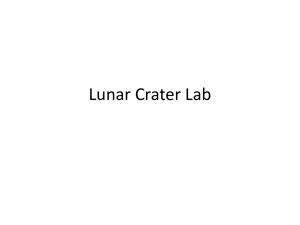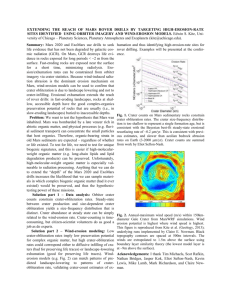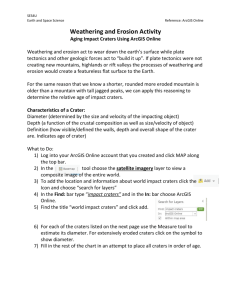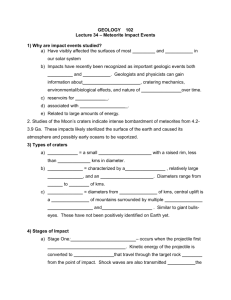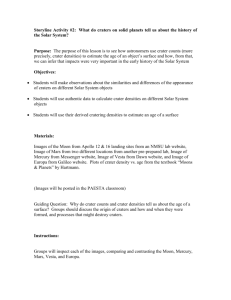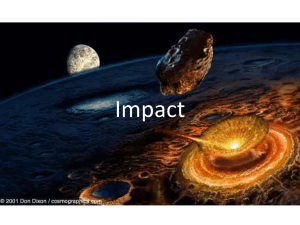Terrestrial Surfaces
advertisement
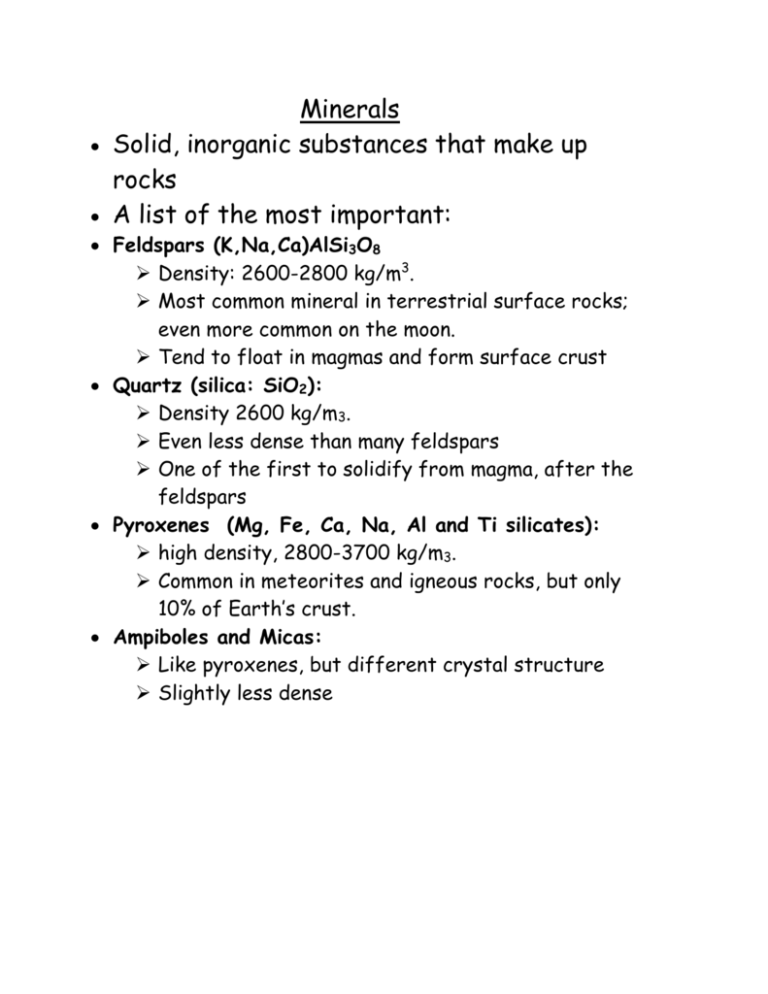
Minerals Solid, inorganic substances that make up rocks A list of the most important: Feldspars (K,Na,Ca)AlSi3O8 Density: 2600-2800 kg/m3. Most common mineral in terrestrial surface rocks; even more common on the moon. Tend to float in magmas and form surface crust Quartz (silica: SiO2): Density 2600 kg/m3. Even less dense than many feldspars One of the first to solidify from magma, after the feldspars Pyroxenes (Mg, Fe, Ca, Na, Al and Ti silicates): high density, 2800-3700 kg/m3. Common in meteorites and igneous rocks, but only 10% of Earth’s crust. Ampiboles and Micas: Like pyroxenes, but different crystal structure Slightly less dense Ices Beyond the asteroid belt, ice becomes a major “mineral” constituent of terrestrial bodies. Water ice Density 917 kg/m3 (at standard temperature and pressure) Dominates the surfaces of many moons and ring particles Main constituent of most comets Also present in the polar caps of inner planets (Mars and Earth) Carbon dioxide ice: Density 1560 kg/m3. Begins to sublime at about 10 AU from the Sun. Ammonia ice: Density 817 kg/m3. Low melting point (195 K), so could be fluid or gas in some slightly heated bodies Methane ice: Low density, 415 kg/m3. Very volatile, low melting temperature. The first to sublime in comets approaching the Sun. Only condenses on most distant bodies. Present on Pluto, Triton and Titan. Other minerals Olivine: High density, 3300-4400 kg/m3. Sinks to the lowest level in a magma Probably a major component of all terrestrial mantles Iron oxides: Related to ordinary rust Both magnetic and non-magnetic forms Responsible for the red soil on Mars Troilite (FeS): High density, 4600 kg/m3. Makes up 5-10% of chondrites Graphite (C): Low density, 2200 kg/m3. Responsible for the low albedo of asteroids and comet nuclei in the outer solar system Clay minerals: Hydrous aluminum silicates Main component of the fine dust on Mars Rocks Solids made of more than one mineral mix of minerals in rocks varies from one part of the SS to another and well as within a given body. The types of rocks and minerals we find, then, are clues to their history and the history of the SS. Igneous rocks: once heated and subsequently cooled The rate of cooling and the temperature and pressure conditions under which they cooled are detectable in their crystalline structure. basalts have been found widely on the surfaces of SS bodies. granitic rocks have a higher % of SiO3 and have undergone several cycles of repeated heating and cooling. sedimentary rocks: formed by deposits of fine grains due to water or wind. Common on Earth where both water and atmosphere are important. The only other place where they have probably been found to date is the surface of Mars. metamorphic rocks: altered slowly under conditions of high T and P Examples are marble (formerly limestone), slate (shale) and gneiss (granite). So far identified only on Earth. Crater formation The energy of impact is so great that it obliterates the impactor and generates a high energy explosion. The formation of an impact crater involves an almost instantaneous transfer of energy, in three stages: impact and compression: In such a hypervelocity impact the energy is transferred to the surface through a shock wave which spreads out in a spherical pattern away from the point of impact. During this very brief (few seconds or less) period the rock behaves almost like a fluid. ejection and excavation: After the shock wave has passed the rock relaxes and a rarefaction wave (essentially a reflection of the original shock wave) travels upward carrying rock with it. The rock is ejected, forming the crater floor and rim. Depending on the energies involved, some of the ejecta will carry well beyond the crater in “rays” which we see especially around young craters. Material ejected directly upward will often fall back, creating a central peak. collapse and modification: As time passes the crater walls may slump forming terraces, the floor may experience additional rebounds from secondary impacts, and the crust generally re-establishes itself over time. Typically the diameter of a crater is D E 1 / 2 and this translates into crater diameter ~10x the impactor’s diameter. Craters and surface age An impact remnant will be produced only if the surface and underlying layers are rigid enough to transmit the shock wave and then rebound. The longer the surface has been rigid, the greater the number of impact craters we will see. So, potentially, we can use crater numbers to tell us surface age For the moon, we see evidence for periods of heavy bombardment at 4.3Gyr and 3.9Gyr ago, after which the rate drops substantially. This makes sense in the context of our model of SS formation in which we expect there to be large numbers of planetesimals left over after the creation of the major planets and satellites. dynamical models suggest that collisions are a major reason we do not see them today. Since we expect all SS bodies to have suffered the same bombardment during the early stages of the SS, we can use this lunar profile to estimate surface ages for other SS bodies. This will provide us with at least relative ages which give some idea of when a SS member cooled enough to have a crust rigid enough to retain impact evidence. Measuring surface ages Atmospheric effects and surface evolution will destroy craters of different sizes. Atmospheres can also have an effect by preferentially destroying small meteoroids and limiting the impact evidence to larger craters. This can be taken into account by plotting cumulative crater density vs crater size. For the Moon, such a plot shows near saturation numbers of craters at all diameters. By contrast, Venus has almost no craters smaller than a few km and the numbers of large craters are well below saturation level, indicative of both a younger surface age than the Moon and greater surface erosion. We also expect that the number of impacts will be different for different bodies depending on their mass and closeness to other massive bodies – i.e gravitational focussing. This effect is modeled and taken into account when using crater density data to estimate surface age.


